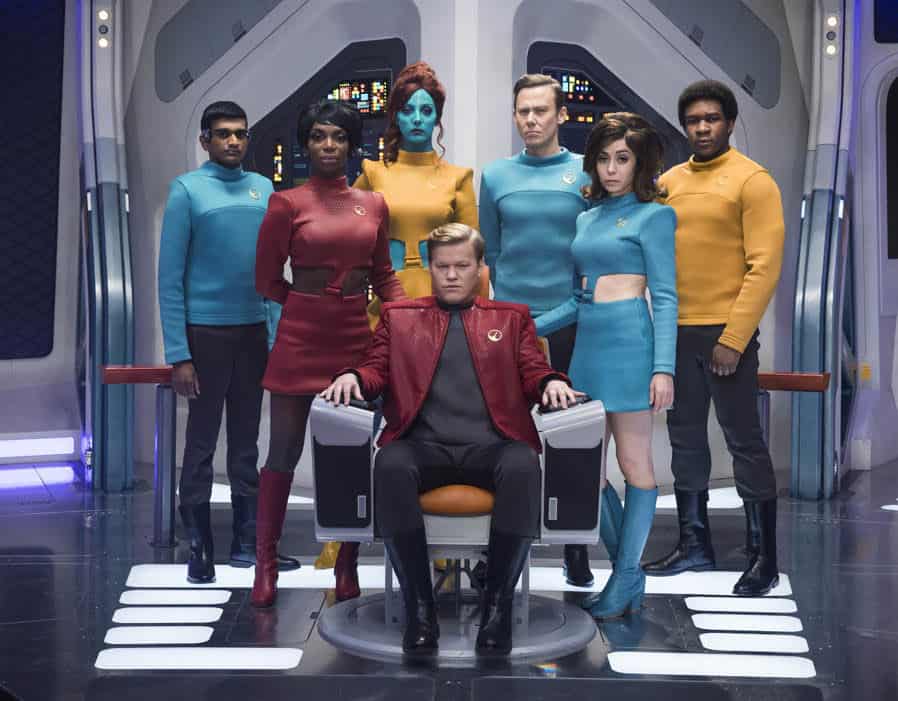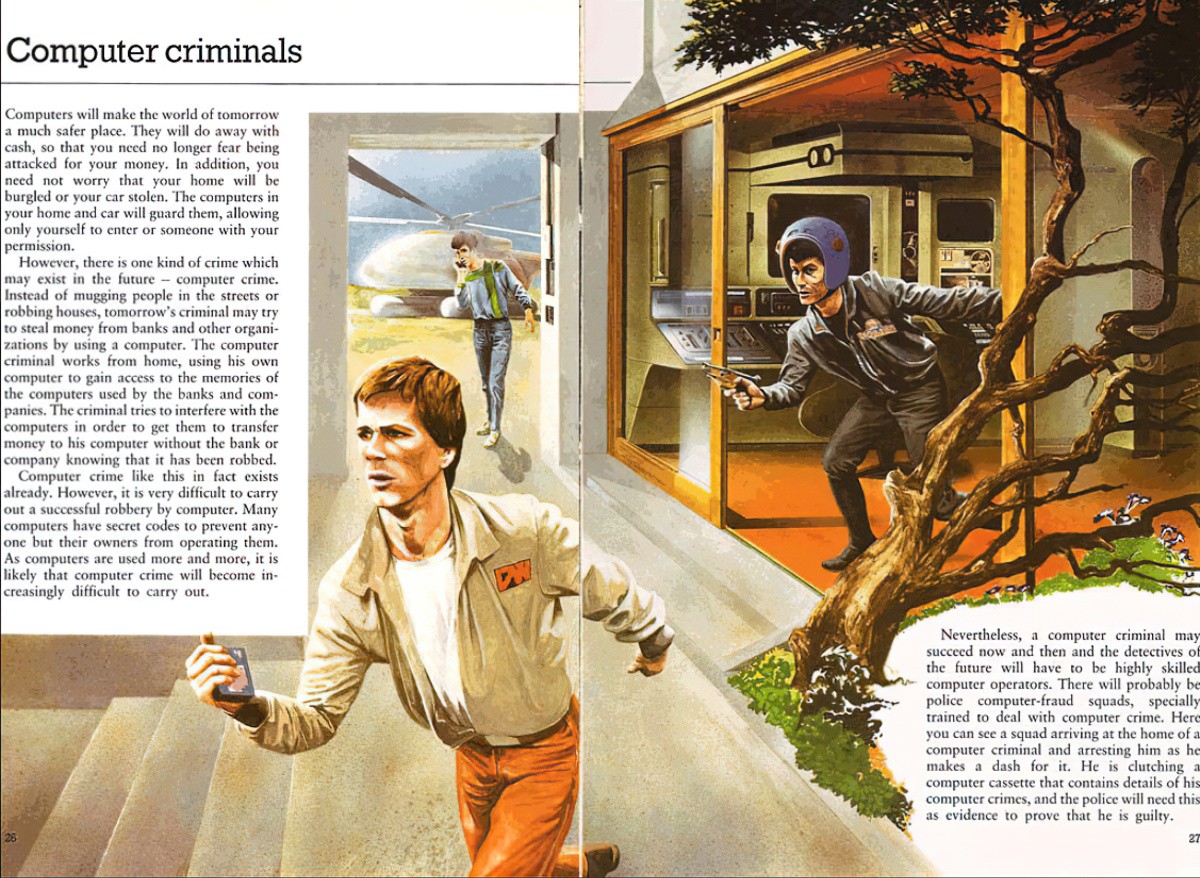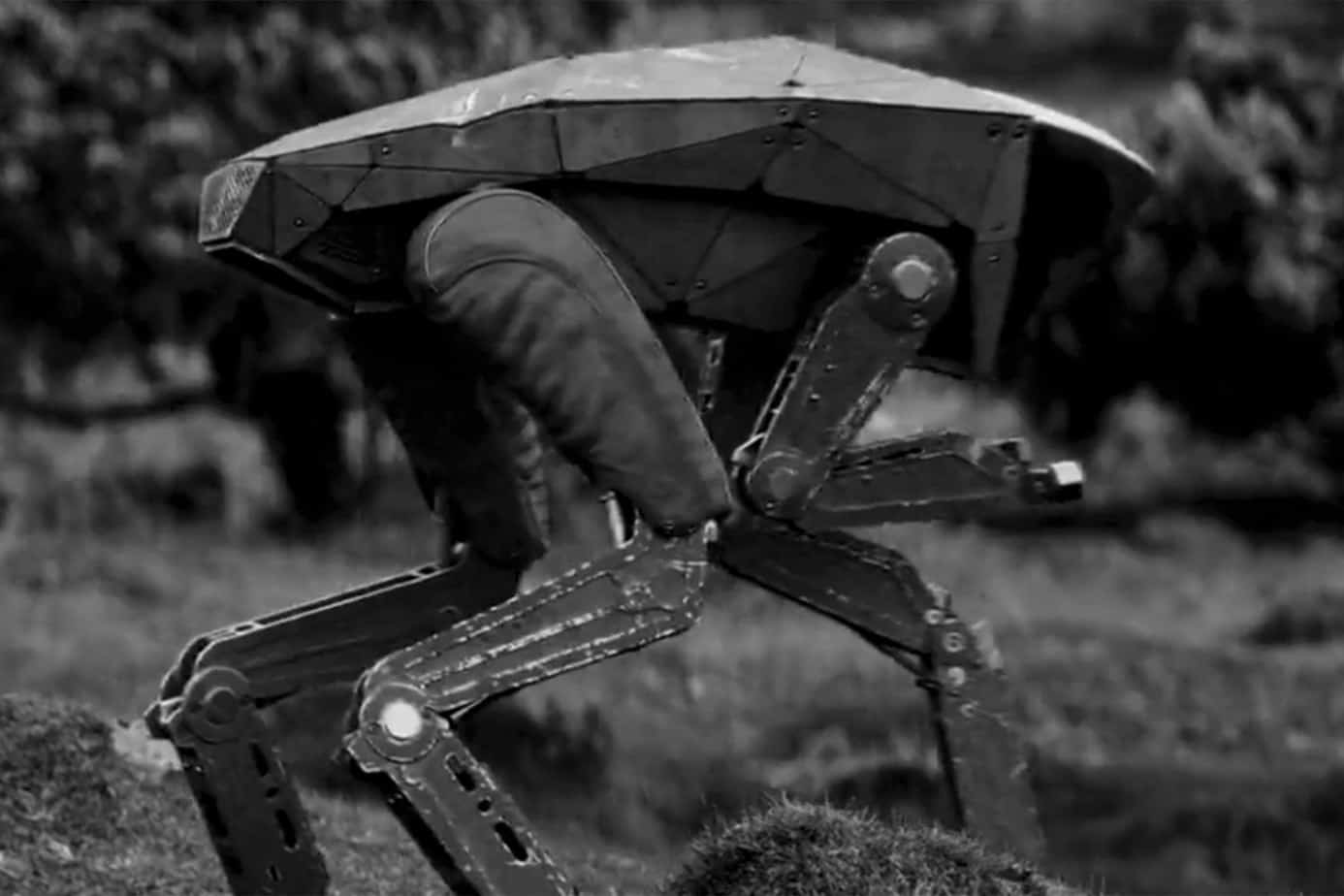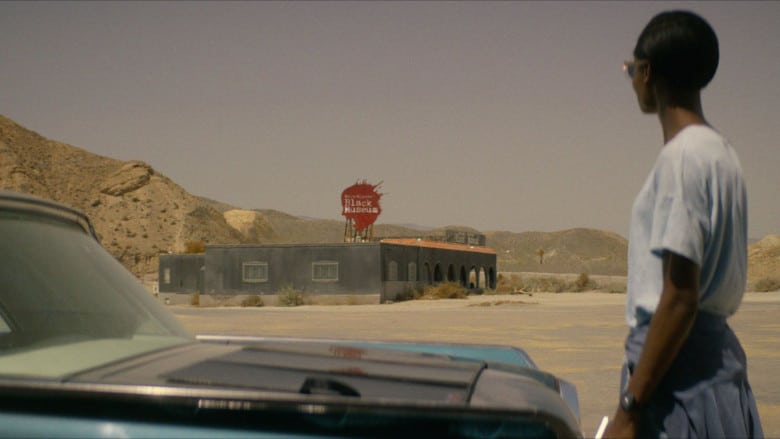Black Mirror is a science fiction anthology series exploring a twisted, high-tech world where humanity’s greatest innovations and darkest instincts collide. Each story says something about our relationship to technology and how technology affects our relationships with others.
SEASON FOUR: USS CALLISTER
LOG LINE: A virtual woman wakes up on a Star Trek-esque ship where the crew praise their all knowing and fearless captain.
Think Inside Out but for adults. As in the Pixar film for children, we have two separate plot lines running in parallel but intricately linked — one taking place in the ‘real world’, the other an ensemble cast of characters who exist only in one of the real world characters’ heads. The ‘main character’ of the ‘real world’ layer is different from the ‘main character’ in the fantasy layer, though I talk more about character function below. As is the case in Inside Out, I feel USS Callister does lag a bit in the middle, but I know this opinion isn’t shared by all types of viewers. Unlike Inside Out, one of the storylines in USS Callister is a happy ending, the other a tragedy.

I’ve seen approximately five minutes of Star Trek in my life, which was enough — given its pop cultural status — to know that the game spoofed in this episode was Star Trek. There’s nothing subtle about that. This genre spoof was the source of its humour — the buttons where it doesn’t matter which one you push, it’s all the same, to the smooth crotches sans genitalia, which is a comment on the sexlessness of Star Trek, but also a comment on the inhuman asexuality thought to be a defining characteristic of the show’s super fans.
The episode opens with a lengthy Star Trek scene which almost lost me as I zone out for the jargon, but then we’re in an elevator with Jesse Plemons’ character and I’m suddenly interested — this is a West World sort of story where a digital gaming life exists beyond the futuristic real world. At first we don’t know if it’s the reverie of a trekkie on his way to work, but sophisticated drama can no longer get away with such simplistic tricks. We know there has to be more to it than ‘then he woke up and it was all a dream’.
The writers use every trick in the book to endear us to Robert Daly. As I’ve already explored in a close reading of the Breaking Bad and Sopranos pilots, when creating an antihero you really need to go over the top to engender empathy first. Daly is:
- very competent — genius, in fact, a ‘sublime coder’
- comically under-appreciated
- we see him humiliated when he trips over someone’s poorly placed sports bag (sports bag to set up your classic nerd vs jock opposition)
- he is further humiliated when we see a couple of colleagues seeming to laugh at his misfortune through glass walls
- he has been socially excluded in the office, shown by him tentatively asking if a guy will make coffee for him, as well as for everyone else
- a reveal is that he is in fact one of the two big bosses, and the fact that everyone is treating him as the underdog when he is the brain behind the entire company feels upside down and very wrong to the audience
- his business partner is a real asshole, flicking him on the back of the head
- but Daly is nice to his underlings, to the point where the underlings are doing the job of project management on their own (Daly’s psychological shortcoming)
Jesse Plemons is the perfect actor for this role, playing both bad guys (Breaking Bad) and underdogs (Friday Night Lights etc.), but always with humanity.
Level of Technical Detail
I watched USS Callister with my husband, who happens to be a developer — not for a gaming company but in cybersecurity.

I noticed that he was far more engaged with this episode than I was, so I’m sure this storyline appeals especially to viewers who are:
- Star Trek viewers
- Work in offices
- Especially developers/testers/project managers and anyone else in that chain
- Gamers
I’m none of those things and my husband ticks all four boxes. I zoned out at the beginning and also later, during the big struggle sequence. “Do you understand what’s going on?” I asked. “Yeah, I get it.” I waited until after the episode before asking him to fill in the gaps.
Turns out I hadn’t missed as many things as I had thought because there are certain parts of the tech we’re meant to gloss over. Namely:
- How do the clones have all their memories to the point that think they’re the same, sentient individual as their real-world counterparts? Wouldn’t they have no memory? This is glossed over in the story but we do hear the phrase ‘sentient code’. There’s no such thing, of course, so we’re not supposed to understand it at all. We’re supposed to just go with the idea that Daly has found some way to clone not only bodies with DNA, but also the memories of the original brain.
- How does Daly get stuck inside the game world when the others get out, into the wider world of the game? It helps to know that by getting through a firewall the digital clones will lose any mods that Daly gave the game. So once they break past the firewall, they’ve escaped him. Asking for more details than that is fruitless because getting stuck inside a game is total fantasy. Thusly, it doesn’t matter how they get in and out.
So that was an interesting case study in how much tech detail is required to satisfy a technical sort of viewer, notorious for pedantry when it comes to fake IT plots written by non-IT people, and almost always fans of mimesis, even in story. As a non-tech viewer, I was left with the feeling I had missed a lot, but now I’ve had a post-episode discussion I’m pretty sure the tech details in this plot work like the buttons on the spaceship — “You can press any one, it doesn’t matter.” Transliteration: “You can make up concepts without explaining them, just so long as the viewer gets the gist.”
Predictability
It has been said of Charlie Brooker’s plot lines that at some point in each story the audience is ‘waiting for the other shoe to drop’. Meaning, events have been set up, they’re in motion, we know what’s going to happen. Now we’re just waiting for it to play out. (Others less generously call this the ‘yeah, no shit’ rule.)
That may be so, but these stories are far from predictable. The interesting settings keep us engaged. I didn’t predict what was happening in this particular episode of Black Mirror, partly because the tech concepts were new to me, but my husband picked immediately that we were looking at a West World sort of plot. He also knew immediately that Nanette was sending the message to her real world self.
When Nanette manages to blackmail her real world self with naked pictures, that is the point we’re waiting for ‘the other shoe to drop’. We know they’re going to get out. This is when the tech details become interesting (for technical viewers) and the humour is amped up a bit (with genre parody of Star Trek, as well as in the acting itself).
Character Functions
What are the character functions of USS Callister?
- The story tricks us into thinking that Robert Daly will be the main character in many senses of the word — the guy we see the most of, the guy we feel empathy for, the guy who will undergo the character arc. But it is soon revealed that Daly is an antihero, and although his circumstances change, he doesn’t really undergo a character arc. His manic laugh at the end puts us in mind of a baddie like The Joker, who has been defeated but hasn’t grown psychologically.
- Nanette is a classic viewpoint character — she’s new to the Infinity Office and to the spaceship, which puts her in the exact same position as the audience. It is Nanette who undergoes a character arc. Okay, technically she doesn’t. Technically she bifurcates early in the story and her clone is put into a position where she transforms from a mild-mannered, fangirling office worker into a powerful leader.
- We empathise at various points with Daly (first), Nanette (second) and maybe even with the clone of Walton after he tells us about how he has been manipulated by Daly and lost access to the real version of his own son. At the end we may even feel a little sorry for Daly, stuck there forever in space. That’s pretty terrible. Unlike the others, Daly isn’t a clone of himself — it’s the real Daly there in the game. A brief shot of him slumped at his computer shows that he is effectively brain dead. Also, the real world Daly is not an asshole. This is an example of a story that really plays with character empathy.
Themes
Thematically, MSS Callister is another story of its time. At the end of 2017 I am put in mind of:
- Men in the workplace who are passive aggressive bullies to other men, because those men are competing for a position in the pecking order. But when it comes to the bullying of women, the woman only needs to piss him off by being sexually desirable and out-of-reach, and then the bullying becomes sexual, also known as sexual assault. Daly is a sexual predator, but only in the virtual world. (Unless swiping someone’s DNA and creating a sentient clone to use and abuse can be considered assault, which I’m sure it can, to be fair.)
- Which plays into how I feel about underdog male gamers. I don’t think I’m alone in thinking that the worst offenders online are probably underdogs in their real lives, and take out their aggression online, with avatars they perceive to be weaker than them (female avatars being worst targeted).
- As usual for a Black Mirror episode, we are asked to consider the gap between ‘the real world’ and ‘the virtual world’, with the inevitable conclusion that these days there is no gap. The person who is an asshole online but meek at work is the same (real) person.
- But as far as that online bully is concerned, others online are not real. To the online bully, he might as well be abusing avatars.
- What does it mean to be a ‘real person’? Is it really so bad to create digital copies and abuse them? Is that abuse? What if the existence of the fake people is the outlet that allows you to make it through your working day among people who you despise, without blowing your top? Is it okay then? Also, were these digital copies real? If they are sentient, aren’t they basically real people, and should be treated as such?
ARKANGEL
LOG LINE: After nearly losing her daughter, a mother invests in a new technology that allows her to keep track of her.

Arkangel is the name of the company trialling chips for parents to implant permanently into their children’s heads in order to keep an eye on them. Archangels are angels higher in rank than ordinary angels (good to know you can’t escape a very human pecking order up there). Why the change of spelling? A reference to Noah’s Ark? Where the apocalypse is coming, and only those in the know will be able to save their children, by means of the latest in technology? I don’t know.
It makes sense that Jodie Foster directed this one — she’s done her share of ‘missing child’ films, notably Flightplan. If the first episode of series four appealed to gamer techie types, this one appealed to parents, especially mothers. I don’t enjoy stories in which a child goes missing. On my daughter’s first day of kindergarten her school put her on the wrong bus. This was a 39C afternoon (102F) in rural Australia, and since I didn’t even know she was on a bus (the school office had closed), that was the most harrowing hour and a half of my parenting life so far. Most parents have lost a kid at some point, if only for seconds. The fear is utilised in this story. Even non-parents are able to empathise with loss of a loved one.
This is the ‘grain’ of season two’s The History Of You, but applied to a child.
Story Structure
It’s a solid plot, following the mainstream conventions of storytelling:
- A single main character (the mother)
- Who is faced with a moral dilemma
- And is eventually set up as an opponent to her own daughter
- Although we are given enough information to empathise with the mother’s decision we do not approve of all of it
- The mother makes a bad decision (to keep using the tracker app) and is punished in the worst way
- Ending in the tragedy of a broken family and a damaged daughter on the path to destruction (reminiscent of Rhonda Volmer’s fate in Big Love, getting into a truck with an unknown man and leaving town.)
Themes
Arkangel is an unsubtle critique of helicopter parenting and censorship, coming down firmly against it. A mother and daughter have a great relationship until the daughter discovers her mother has been spying on her in her most intimate moments. And I guess that tablet is not based on an Apple iPad, because it is used to bludgeon the mother’s head without shattering the screen.
At what point do we lose empathy for the mother? The mother is a good antihero because I understand her motivation at all times, even while disapproving of her methods. I never lost empathy for the mother, but it’s clear from the moment the chip is implanted where this story is going to go. It goes exactly where you think it’s going to go. This is another ‘waiting for the second shoe to drop’ plot. But that’s okay. It’s still a gripping story. Arkangel is an example of a story which is predictable but still satisfying. Not everyone agrees:
It feels like one of those lightbulb ideas of Charlie Brooker’s that sputters and dies in the execution, a bit like last season’s “Playtest.”
Sophie Gilbert
As Gilbert goes on to say, the interest in this story is not in the plot — it’s in the message:
Far more interesting to me was the episode’s subtext about what kids already have access to. When young Sara’s chip is turned off, a kid in her class shows her hardcore porn and execution videos on his iPad with disturbing nonchalance. Later, in her first sexual encounter, Sara mimics the women she’s seen in pornography, horrifying her mother, who’s turned on the long-dormant Arkangel device to find out where her daughter is. The impact of this kind of instant access to adult imagery is as novel as the implant is, and as unclear.
Where the message itself falls short:
But the episode seems more concerned with lining up a tidy parable about helicopter parenting than peeking into the prospects of the nearer-present.
The story itself doesn’t offer its audience anything new in its ideas, but what it can do is open up a dialogue. This is a Black Mirror episode I would like to watch with my daughter at some stage, to open up a discussion about parental surveillance and its limits. Because we’re already here. We already keep track of our children using the preinstalled Find My Friends app, or with a GPS wristband. The photographing of everything and its obligatory uploading onto social media means parents know far more about the current generation of teenagers than they ever knew before.
Side note: When the daughter has been shielded from anything raising her cortisol levels she is eventually unable to read situations correctly. A psychologist tells the mother ‘I don’t think it’s autism.’ I’m grateful for this snippet of dialogue because there’s this erroneous idea circulating that ‘too much screentime causes autism’. Sometimes when storytellers (accidentally) create stories which intersect with certain popular but bad ideas it’s necessary to forestall misreadings in this way.
Further side note: I blame Charlie Brooker first and foremost, but there were women working on this episode. A woman directed, women acted the parts. I can’t understand how misinformation about the emergency contraceptive pill slipped past. “Emergency contraception, for terminating a pregnancy,” are the words. Emergency contraception is for preventing pregnancy, not terminating it. This kind of misinformation has real world effects.
CROCODILE
LOG LINE: A woman interviews various people using a device that allows her to access their memories.

This wasn’t a good episode. It felt recycled and unoriginal — partly because Charlie Brooker seems to be borrowing from his own self, with another chip stuck to the side of the head. This is another take on the The History Of You episode, which was very strong and felt totally original. This episode even recycles a song from an earlier episode. I wonder if this was deliberate or due to budget constraints.
There’s nothing engaging about watching a character dig themselves into a deeper and deeper hole, involved peripherally in a murder, then making a huge leap as murderer, then serial murderer, then baby murderer. The motivation here didn’t feel strong enough.
This routine murder plot is improved by the parallel plot of the woman whose job it is to interview witnesses to crime scenes, recording their memories then amalgamating them to establish the truest account of an event. But even here, there’s no time to see her as a person — we only see her doing her job (empathetically) and also getting a guinea pig, which you just know is going to function as a Chekhov’s Gun, because there was unusual emphasis on it. The scene where she is given the guinea pig does accomplishes nothing but to show her in the home environment — in order to avoid acting like a big giveaway (at a certain point, after the reveal that the baby was blind), its introduction would’ve needed to be more subtle.
But maybe the writer wanted us to guess correctly that the guinea pig was going to be used. I was really looking forward to seeing inside a guinea pig’s head but alas, the episode ends before we get to see it! I imagine including guinea pig observations would tip the sci-fi thriller horror into comedic territory though, because some people have attached GoPros and heart rate monitors to their dogs and those are pretty darn funny.
David Sims pinpoints the main problem with the plotting of this episode:
Any hint of lingering humanity is quickly erased as Mia turns into a rampaging monster. Soon, she’s only killing people to set up further plot points in an episode that turns into a strange sort of treatise on body cameras and crime surveillance.
The Atlantic
As I was watching it I got a little bored by the story and it’s not until the insurance agent’s storyline is introduced that we get any sci-fi stuff at all. Unfortunately that’s why you sit down to watch a Black Mirror episode. Without the sci-fi tech stuff, some of the plots aren’t strong enough on their own, and Crocodile is one of example.
HANG THE DJ
LOG LINE: A new dating app hits the scene, where the matched couples are told how long their relationships will last.

Romance is really hard to write, despite all the genre beats being there for you, and despite romance genre readers expecting a happy ending and therefore predictability. One of the reasons romance is so hard to write is because in contemporary Western culture it’s hard to come up with a reason to keep two romantic opponents apart for the entire length of a movie. People tend to get together early on these days, so the sexual tension is cut short. The fact that this is a TV length episode and not a movie helps the writer, too. Yet, as others have noted, it still sagged in the middle a little. That’s how hard it is to write romance. I don’t think romance is Brooker’s particular thing.
I enjoyed “Hang the DJ” a lot, although it sagged a little in the middle, like Black Mirror episodes tend to do.
Sophie Gilbert
Charlie Brooker has taken the technology of dating apps and swung the hook-up culture in the opposite direction, leading once more to a conservative, dystopian, The Giver type scenario in which technology is used to take choice and control away from people looking for love. The technology itself is keeping two lovers apart. (Ostensibly.)
This episode is traditionally satisfying because the nature of the technology is explained early on. Also, the main characters are empathetic and we relate to their very human plight. Even more satisfying is the massive reveal at the end, harking back to the San Junipero episode in which we find out these people are VR. But in San Junipero, suddenly things that didn’t make complete sense, do. For instance, the women in San Junipero are outrageously blase about a near-death experience with a car wreck. This makes sense in hindsight, when we realise they can’t die inside the simulation, because they’re already dead on the outside world. Hang the DJ isn’t as satisfying in that respect because the angst and anguish over sleeping together and the annoying tics and the unsatisfying sexual experiences don’t map well onto a VR world.
METALHEAD
LOG LINE: A black and white film about a woman attempting to survive a dangerous land full of “dogs”.

Kudos to the CGI studio who made that creepy ass dog beetle thing because the success of this episode hangs on the sheer terror of being chased in a cat-and-mouse plot where Charlie Brooker hasn’t told us any backstory whatsoever, including why this woman is breaking into the warehouse and why she is being chased. In other words, we don’t see her psychological shortcoming (though her ‘moral shortcoming’ might be ‘breaking into places she shouldn’t’). Her only desire is surface level — to get something from a warehouse, then to escape with her life from a terrifying machine. We don’t see any ‘under the surface’, psychological desire. This is a straight horror, without the character development. It is what it is.
We do get a few clues at the end — she’s breaking into the warehouse to get a teddy bear, for a child? My husband found this episode far more satisfying than I did. He didn’t care why she was being chased. But I don’t watch a story for the thrill alone — I felt frustrated that we were given nothing, nothing at all — just plonked into what is effectively someone’s nightmare — no context, just terror. Hearing about someone’s nightmare is more riveting than hearing someone recount a random, absurdist dream but… only just?
I suspect the team who came up with this story have seen the horrifying videos coming out of MIT’s robotic department.
Then again, there’s a real life analogue and reality is even more scary than fiction.
The Russian military is … investing heavily in new technologies to transform its armed forces, developing robots that are capable of mounting operations to evacuate wounded soldiers from the big strugglefield and to diagnose and treat casualties. Researchers are also working on biomorphic robots like the four-legged Lynx, which will be equipped with a machine gun and anti-tank guided missiles and will be able to operate in conditions including on ice and in sand that would test, challenge and tire human soldiers.
The New Silk Roads, Peter Frankopan (2018)
It’s called Laikago.
BLACK MUSEUM
LOG LINE: An anthology of its own, a woman enters the Black Museum where the proprietor tells her stories relating to the artifacts.

The tech plot in this one seemed to drill down deeper and deeper in a kind of vortex plot, a mise en abyme of embedded consciousnesses. It gets confusing if you’re on your phone at the same time. Even so, I was able to guess who the young black woman is.
If Stephen King put you off clowns, this may well put you off monkeys.
This desert museum functions as a kind of hell-on-earth, but I was strangely reminded of Willy Wonka. Here we have a man who takes great delight in showing off his macabre little world. This tour guidance looks and feels more like stage performance. Like Wonka, the tour guide in Black Museum displays “a frightening combination of warmth, psychosis, and sadism”.
Charlie Brooker has imagined a more realistically diverse future in many ways — mixed race couples, for instance, and a Muslim insurance agent in a previous episode. But in Brooker’s vision of the future gender dynamics are as cliched as ever. It’s mothers who become problematic helicopter parents, and Hang The DJ couples are 100% hetero, despite a huge number of young people identifying as queer even today.
In Black Museum I rolled my eyes at the wife inside the husband’s head, reminding him to wash his hands, vaguely disgusted by his bodily functions in a prissy, motherly kind of way, despite being his former lover. The episode could have been written the other way around (the husband inside the wife’s head) but I suspect we would’ve had an inverse set of sexist tropes. (A husband who gets sick of watching rom-coms, overly interested in looking at himself naked in the mirror etc.) It remains very difficult for writers of sci-fi to reimagine a world in which gender norms have been challenged. Yet these same writers have no problems coming up with original and interesting technological scenarios. I conclude that these writers don’t even want to imagine a world in which a wife inside a husband’s head might, say, become as masculine as the husband himself, because she has become one with him. Or a man who learns to embrace femininity.
Season Four of Black Mirror has been patchy but compulsory viewing for me. Brooker has done a great job of taking either an accepted or negative truism about certain technologies then flipping to its ironic opposite outcome. I did feel that Brooker is borrowing from his own work a little too heavily, suggesting he’s running out of ideas, or is being pushed too fast to create. Next season I would love to see revisionings of what it might look like to exist as human alongside these future technologies, rather than simply plugging 2017 humans into a projected future. Of course, sci-fi has always been about current times, never really about the future. Even so, sci-fi writers need to take the least conservative (most progressive) version of 2017 if they want to get anywhere near close to challenging the collective imagination.
- Fathers who look after children
- Gender tropes subverted
- People who understand what the emergency contraceptive pill actually does
- Queer sex normalised and fully catered for in popular apps
- Female villains who actually have some depth
- Black doctors who are the stars of the show, not just black sidekicks and scrappy underdogs
That kind of thing.
FURTHER READING
Three short films about surveillance
- Blaxites highlights issues that arise when different data systems are connected.
- A Model Employee examines data ownership and the need to earn a system’s trust.
- Frames exposes the problems in trusting sensor data and facial recognition to interpret human behaviour.
THEOLOGY AND BLACK MIRROR (2022)
edited by Amber Bowen and John Anthony Dunne
- Ethics through a Dark Lens: Ellul’s Technological Morality in Black Mirror by Peter Anderson
- Barbarism, Boredom, and the Question Concerning P*rnography in Fifteen Million Merits by Amber Bowen
- Free Will and (In)determinity in Hang the DJ by Taylor W. Cyr
- Too Many Twos: Ashley and the Artificial Authentic by Elizabeth Howard
- Smithereens as Technological Theodicy: Addiction, Emergence, and Resistance by John Anthony Dunne
- Arkangel and the Death of God: A Nietzschean Critique of Technology’s Soteriological Scheme by Amber Brown and Megan Fritts
- Seeing and Being Seen in a Black Mirror, Dimly: Phenomenology and the Dim View of White Christmas by King-Ho Leung and Patrick McGlinchey
- Evil Gods and the USS Callister by Celina Durgin and Dru Johnson
- Crowdsouring Judgment: The Dark Side of Justice in Hated in the Nation and the Johannine Trial Narrative by Andrew J. Byers
- Re-Dos and Re-visions: Replay and the Search for Meaning in the Shepher of Hermas and The Entire History of You by Jeremiah Bailey
- King David and the White Bear Justice Park by Rachelle Bailey
- Alternate Eyes: Perspective Shifting in the Samson Narrative and Black Mirror by Brandon M. Hurlbert
- “Not Some Crazy Spiritual Thing”: Rewards, Punishment, and Afterlife in Black Mirror by James F. McGrath
- Be Right Back and the Ethics of Mourning: (In)Authenticity and Resurrection in the Digital Age by Rebekah Lamb and Joanna Leidenhag
- Reflecting the Infinity or the Finite? The Mirror Motif in Black Mirror and Gregory of Nyssa by Elizabeth Culhane
- Memoria and The Entire History of You by Nathanial A. Warne
- Look Door, Get Key: Presence in Black Mirror’s Bandersnatch by Douglas Estes
- Where are You?: San Junipero and the Technology of Shared Space by Kris Song
- Uploaded to the Cloud: Transhumanism and Digital Hope in Black Mirror by John Anthony Dunne
